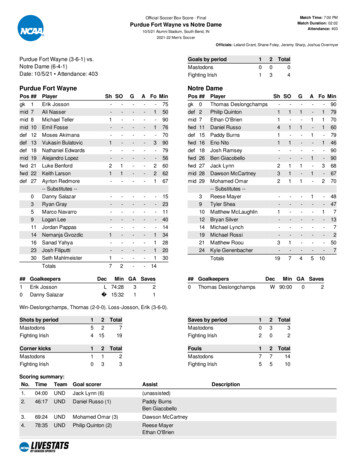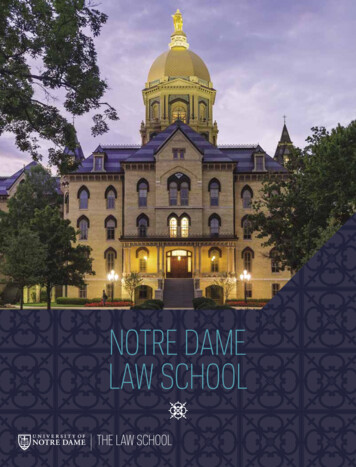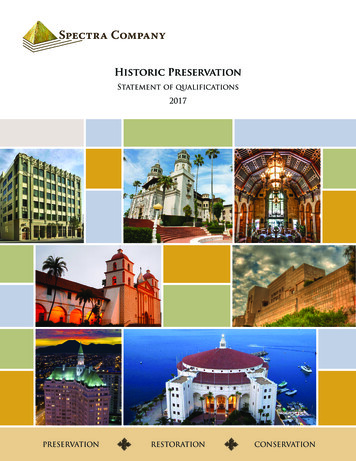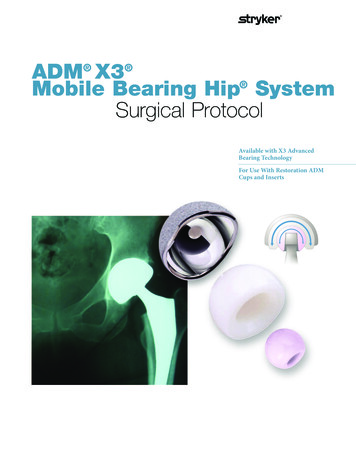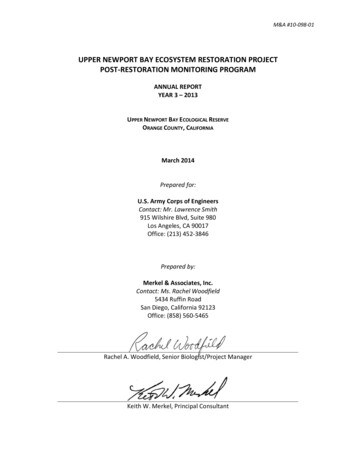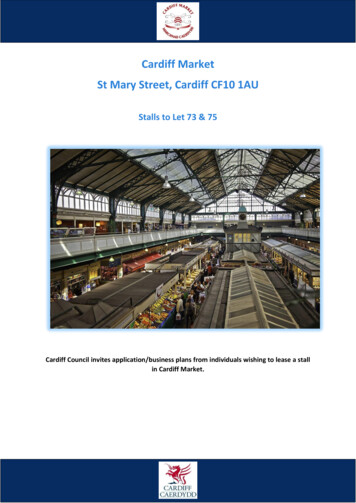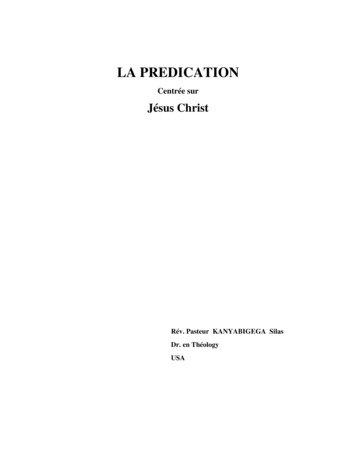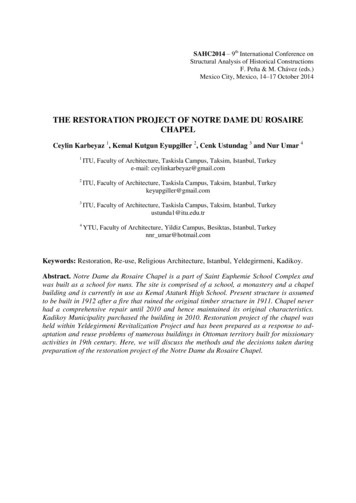
Transcription
SAHC2014 – 9th International Conference onStructural Analysis of Historical ConstructionsF. Peña & M. Chávez (eds.)Mexico City, Mexico, 14–17 October 2014THE RESTORATION PROJECT OF NOTRE DAME DU ROSAIRECHAPELCeylin Karbeyaz 1, Kemal Kutgun Eyupgiller 2, Cenk Ustundag 3 and Nur Umar 41ITU, Faculty of Architecture, Taskisla Campus, Taksim, Istanbul, Turkeye-mail: ceylinkarbeyaz@gmail.com2ITU, Faculty of Architecture, Taskisla Campus, Taksim, Istanbul, Turkeykeyupgiller@gmail.com3ITU, Faculty of Architecture, Taskisla Campus, Taksim, Istanbul, Turkeyustunda1@itu.edu.tr4YTU, Faculty of Architecture, Yildiz Campus, Besiktas, Istanbul, Turkeynnr umar@hotmail.comKeywords: Restoration, Re-use, Religious Architecture, Istanbul, Yeldegirmeni, Kadikoy.Abstract. Notre Dame du Rosaire Chapel is a part of Saint Euphemie School Complex andwas built as a school for nuns. The site is comprised of a school, a monastery and a chapelbuilding and is currently in use as Kemal Ataturk High School. Present structure is assumedto be built in 1912 after a fire that ruined the original timber structure in 1911. Chapel neverhad a comprehensive repair until 2010 and hence maintained its original characteristics.Kadikoy Municipality purchased the building in 2010. Restoration project of the chapel washeld within Yeldegirmeni Revitalization Project and has been prepared as a response to adaptation and reuse problems of numerous buildings in Ottoman territory built for missionaryactivities in 19th century. Here, we will discuss the methods and the decisions taken duringpreparation of the restoration project of the Notre Dame du Rosaire Chapel.
Ceylin Karbeyaz, Kemal Kutgun Eyupgiller, Cenk Ustundag and Nur Umar1LOCATIONNotre Dame Du Rosaire Chapel is located in Yeldegirmeni neighborhood in Kadıkoy, Istanbul (Figure 1). On the Asian side of Istanbul, Kadikoy is surrounded by Uskudar in north,Atasehir on east and Marmara coast on south and west. It is the 6th most populous in 39 provinces of Istanbul with 532.835 inhabitants [1]. Yeldegirmeni is located across Haydarpasa bayand surrounded by Recaizade Street in south, Anatolian Railway line in east and north, RihtimAvenue in west. It is a neighborhood of Rasimpasa district along with Haydarpasa,Ibrahimaga, Talimhane and Sogutlucesme neighborhoods [2].Figure 1: Istanbul City Map, [3]On June 5th, 1998, Yeldegirmeni is declared as 'Urban Conservation Area' by the 2ndPreservation Board [4]. Yeldegirmeni (Windmill) neighborhood was called after constructionof four windmills producing flour for Ottoman Palace between 1774 and 1789. Populationresided in the neighborhood mainly consisted of Turks and Roums until 19th century whenJews began to settle down after a major fire in Kuzguncuk which caused a much complexethnic structure. Yeldegirmeni Urban Conservation Area is composed of steep narrow roadsand small squares. Architecture in this area varies depending on different ethnicities in theneighborhood existing for decades. Architecture dominant in the region is similar to that ofTarlabasi, Kuzguncuk where non-Muslim population is concentrated in late 19th century. 3-4story timber frame or brick masonry houses were built in rows which mostly don't have frontor side courtyards. Houses were mostly constructed in Art Nouveau style with empire or baroque details and usually have projections [5].Yeldegirmeni Revitalization Project was started in August 2010 by Kadikoy Municipalityand the Foundation for the Protection and Promotion of the Environment and Cultural Heritage (CEKUL) as primary actors. It aims sustainable and holistic interventions to physically,socially and economically deteriorated urban texture and preserve local values of an urbancenter in Asian side of Istanbul which has a unique historical identity. Unlike numerous ongoing profit oriented projects in Istanbul, Yeldegirmeni Revitalization Project was designed taking local and social consequences into consideration.Private parties as well as various non-governmental organizations like "Our Streets Foundation", "Yeldegirmeni Volunteers" and “Earth Foundation" contributed to the project. Butthe most crucial role is played by local residents whose participation was essential since localnetwork and public participation plays a very important role in socially sustainable recovery.2
The Restoration Project of Notre Dame du Rosaire ChapelProject can be considered as reformist in the way it sets local residents to intervene their ownneighborhood instead of government or private parties which may cause a destructive socialgentrification that has recent examples in city history. Project is managed by a communitycenter which is located in the neighborhood and a group of voluntary inhabitants directly participate in administration and thus transforming neighborhood with residents in a harmoniousand sustainable way [6].Scope of the project involves physical projects such as renewal of infrastructure, preservation and reuse of historic buildings, creation of public spaces, facade arrangements as well associal projects like local residents and tradesman's associations, establishment of communityorganizations and workshops. It also aims to get integrated with city scaled projects likeMarmaray Project, Anatolian Rail Project, Haydarpasa Project in long term [7].2HISTORY"Notre Dame du Rosaire Chapel" was constructed as part of a nun's school called "LaNouvelle Eglise et La Pensionnat Sainte-Euphemia" (Figure 2).Figure 2: Site Plan-Survey (Karbeyaz, Eyupgiller, 2009)It was established in 1895 as an unlicensed school for girls and has been certified in 1913.A document found in the Prime Ministry Ottoman Archives dated September 17, 1912 statesthat the complex was built in three units as school, monastery and chapel and was entirely destructed after a major fire that took place in 1911 [8]. In 1935 school administration washanded over to the Ministry of Education and the name of the school was changed as KemalAtaturk High School. Chapel has been abandoned and rarely used until it started to serve Kemal Ataturk High School as a gym. It was completely isolated after the 1999 Marmara Earthquake which caused structural damages to the building [9-10].Today, monastery part of the complex hosts Kemal Ataturk High School while schoolbuilding is abandoned. Chapel building was partially abandoned while basement floor wasserving as meeting hall and 3rd floor was in use as a part of school library. Monastery andSchool buildings were registered as 2. Degree architectural monument on June 16, 1981 bythe High Council of Immovable Monuments and Antiquities while chapel building was registered as 1st degree architectural monument on April 13, 2011 by the Istanbul Cultural andNatural Heritage Preservation Board- No.5 Regional Board. Within files of complex in registration board, it is stated that the school building was damaged due to excavation work in ad-3
Ceylin Karbeyaz, Kemal Kutgun Eyupgiller, Cenk Ustundag and Nur Umarjacent lot and needs to be evacuated and chapel building can be rented as gym to school management since it lost its characteristics as a religious building (Figures 3-5), [10].Figure 3: First Floor Plan-Restitution (Karbeyaz, Eyupgiller, 2009)Figure 4: Section-Restitution (Karbeyaz, Eyupgiller, 2009)Figure 5: Section-Restitution (Karbeyaz, Eyupgiller, 2009)Regarding the architect of Chapel, a signature on construction drawings in school archivecould be read as "E. Girije" . "Annuaire Orientale Trade Annuals" includes an architect named"Emile Griet" who was active in Istanbul between 1892 and 1895 but no further informationcould be obtained [11]. Design of chapel is very similar to chapel in St. Joseph High Schoolin Kadikoy, thus is assumed to be designed by the same architect which could also be eitherPerpignani, Michelini or Augier (Figure 6), [12].4
The Restoration Project of Notre Dame du Rosaire ChapelFigure 6: Photo Demonstrating Chapel Interior (Kadikoy Municipality Archives, 2011)3ARCHITECTURAL DESCRIPTIONLocated at the intersection of Taslibayir and Iskele Streets, chapel building occupies lot 22of block 205. Monastery and chapel buildings unite in a U-shaped single building surroundinga courtyard in south. It is approximately 30.0mx10.0m in size reaching 16.0m of height in thecourtyard (Figure 7).Figure 7: First Floor Plan-Survey (Karbeyaz, Eyupgiller, 2009)3.1Planimetry and Spatial FeaturesChapel building has 4 stories. Entrance to basement floor is only available through innercourtyard. There is a meeting hall including a stage and 4 rooms in basement floor. First floorhas 2 entrances from south and north. Main entrance is from south on Iskele Street. There aretwo priest rooms, nave, apse, narthex, lavatory and staircase on first floor. Partial 2nd-galleryfloor is open to nave in north and was used as depot, while partial third floor can only be entered through monastery building and was used as library (Figure 8).Figure 8: Section-Survey (Karbeyaz, Eyupgiller, 2009)5
Ceylin Karbeyaz, Kemal Kutgun Eyupgiller, Cenk Ustundag and Nur UmarSouth facade of chapel which overlooks Iskele Street is the most remarkable one (Figure 9).Chapel and monastery buildings are perceived as a whole on this facade whose total width is39.0m while chapel occupies 10.0m of it on west. Chapel is 15.0m of height on this facade.The presence of chapel was distinguished by some significant variations like “Eglise N. D. DuRosaire" inscription and a remarkable entrance. South facade of chapel is coated with artificial stone which was a common application in late 19th century in Istanbul [13]. Based onsouth facade characteristics of chapel, it can be classified as Neo-Renaissance in architecturalstyle.Figure 9: South and North Facades-Survey (Karbeyaz, Eyupgiller, 2009)Chapel can be perceived as a separate building from west, north and east facades which areplainly painted on plaster and have no significant characteristics (Figures 9, 11, 12).3.2Construction Techniques and MaterialsThe foundation could not be investigated on site, however 0.50m thick foundation wallswhich are supported by 0.50m thick rubble walls and a drainage could be observed on historical construction drawings obtained from Kemal Ataturk school archives.Figure 10: Section-Survey (Karbeyaz, Eyupgiller, 2009)Walls of chapel were mainly constructed as brick masonry where on basement level stoneand brick were mixedly used. Brick arches in basement walls were used to reduce load.Thickness of load bearing walls along the building changes between 0.45m to 0.90m whilethe thickness of the non-bearing walls are between 0.15m to 0.30m.French Vault (Volta) floor technique was used all along the building. Width of vault archesvaries between 0.45m-0.60m while width of steel beam is 0.10m. Vaults are supported by ironI-beams beams in basement floor.6
The Restoration Project of Notre Dame du Rosaire ChapelNave in first floor is topped by a 20.0mx10.0m tunnel vault at the height of 9.20m and isroofed by timber hipped roof structure tiled with Marseilles tiles on top (Figure 10, 11).Figure 11: East Facade-Survey (Karbeyaz, Eyupgiller, 2009)3.1 Deterioration1999 Marmara Earthquake and elevation changes in adjacent lots caused structural damages to the building. Structural cracks were noted in the north part of the chapel. Vertical cracksalong north basement and first floor walls point out an elevation change in the ground. Vegetation on north part of the building also widened structural cracks.South part of roofing was severely damaged and horizontal structural cracks could be noted along east, north and west facades (Figure 9, 11, 12).Humidity was one of the major problems along chapel and caused material deteriorationsespecially in basement floor and on the vault of the nave.Although chapel was not intervened elaborately, it is possible to track an annex constructed adjacent to north wall of chapel. Annex was demolished leaving plaster decay on northwall. Original stained-glass windows were also intervened unskillfully through time.Figure 12: West Facade-Survey (Karbeyaz, Eyupgiller, 2009)4RESTORATION PROJECT OF NOTRE DAME DU ROSAIRE CHAPELRestoration project was officially approved on 30 November 2012 by Istanbul Cultural andNatural Heritage Preservation Board- No.5 Regional Board and is completed in 2013 [10].During restoration studies, structural and material deteriorations were identified and interventions were investigated to eliminate causes. Decisions were taken to allow building use asa ‘Cultural Center’ in accordance with the historic nature of building (Figure 13, 14).7
Ceylin Karbeyaz, Kemal Kutgun Eyupgiller, Cenk Ustundag and Nur UmarFigure 13: Gallery Floor Plan-Restoration (Karbeyaz, Eyupgiller, 2011)Figure 14: Section-Restoration (Karbeyaz, Eyupgiller, 2011)All gates and interior connections between monastery building and chapel building wereclosed except emergency exit on third floor. Vertical circulation established in the building.Original wooden staircase on southwest corner is extended to basement and third floor usingidentical materials and construction techniques. Another wooden staircase is added on northwest corner using original techniques. Rooms which originally functioned as lavatory onsoutheast corner of basement and first floor are replaced with an elevator shaft in whole building considering handicapped people and decor transfer along the building (Figure 14, 15, 16).Figure 15: Section-Restoration (Karbeyaz, Eyupgiller, 2011)Basement floor is designed as a multi-purpose hall for 64 people to host amateur theater,music and dance exhibitions. Non-genuine additions were eliminated, original windows wereopened. Lavatories and technical rooms were added. Floor level is lowered to courtyard level.Floor heating is installed while natural ventilation is recommended (Figure 17).8
The Restoration Project of Notre Dame du Rosaire ChapelFigure 16: East and North Façades - Restoration (Karbeyaz, Eyupgiller, 2011)On the first floor, nave and narthex are divided by three wooden panels. Narthex is allocated for security and cloak-room using demountable wooden panels. Nave is designed as a multipurpose hall for panels, exhibitions or chamber music activities for 96 people (Figure 18, 19).Wooden floor of apse was lifted and stained-glass windows were designed in the navebased on information obtained from historical photos. Windows in the nave and apse wereconsidered to be sufficient for natural ventilation of entire space. Former priest's rooms aretransformed into backstage by small interventions and a wooden staircase is added to connectroom to basement floor. All ornamentations and decorations on tunnel vault and apse on firstfloor is preserved and completed according to photos obtained during restitution studies.Room added to on the north to cover original apse semi-dome is removed (Figure 21).Semi-dome is exposed and covered with a hipped roof as shown on historical maps [14].Figure 17: Basement Floor Interior (Right: Karbeyaz, 2009; Left: Umar, 2013)Figure 18: First Floor Interior (Right: Karbeyaz, 2009; Left: Umar, 2013)Gallery floor is designed to serve as a cafe for the entire building (Figure 20).Third floor is allocated for administration of Cultural Center. Elevator shaft was added onsoutheast corner and wooden staircase is extended along the building on the southwest corner9
Ceylin Karbeyaz, Kemal Kutgun Eyupgiller, Cenk Ustundag and Nur Umarof the room. The entrance to the monastery building is preserved as emergency exit. The window on north wall is opened to provide access to roof which was inaccessible.Removal of non-genuine additions was one of the main interventions recommended duringrestoration project. Unskilled additions in basement and ground floors were removed, originalclosed windows were opened and lighting and heating elements were renewed. Stained-glasswindows were designed based on old photos and postcards of the chapel. Entrance was retained on south facade, through the main gate on Iskele Street. Gutters were also renewed andreplaced.Humidity was one of the main problems. Thus, existing drainage system was renewed anddrainage pipes were enlarged where necessary.Figure 19: First Floor Floor Interior (Umar, 2013)Surface cleaning was recommended regarding the pollution, plaster erosion and dense vegetation on walls of chapel. Facades were completely scraped off old plaster and replastered.Dense vegetation on northwest corner of chapel was also removed and wall facades were disinfected by ‘Herbicide’ in order to prevent reemergence (Figure 21, 22).Figure 20: Gallery Floor Interior (Umar, 2013)Cracks observed in chapel were classified into two categories: structural and superficial.Structural cracks emerged due to soil settlement around foundation walls. Cracks betweennave and apse and on top of apse windows were significant results of ground settlement. Horizontal structural cracks were noted on northern, eastern and western facades due to later interventions on facades. Superficial cracks were however, generally seen on plaster, due toremoval of non-genuine annexes.10
The Restoration Project of Notre Dame du Rosaire ChapelFigure 21: North Facade (Right: Karbeyaz, 2009; Left: Umar, 2013)Timber roof structure, wood finishes and wooden doors and windows inside the chapelwere completed or replaced. Gypsum ornaments and stone window sills were also completedand exposed.Figure 22: South Facade (Right: Karbeyaz, 2009; Left: Umar, 2013)5CONCLUSIONFigure 23: Opening Ceremony (Kadıkoy Municipality, 2014)Notre Dame du Rosaire Chapel is restored as a "Cultural Center" considering its role within Yeldegirmeni Revitalization Project and minority of current Catholic population in theneighborhood. During meetings held with Kadikoy Municipality, it has been especially statedthat building should be restored preserving its original religious identity so that it can serve asa church for Syriac people from surrounding neighborhoods in the future .Restoration and re-use decisions were taken in harmony with cultural heritage values andhistorical structure of building. Nonhazardous interventions were proposed while importance11
Ceylin Karbeyaz, Kemal Kutgun Eyupgiller, Cenk Ustundag and Nur Umarof active use of such historical constructions is emphasized for preservation and transfer ofcultural heritage to future generations. Project brought Kadikoy Municipality 'Union of Historical Towns Award' in 2012. The restoration work is completed in 2013 and the Notre Damedu Rosaire Chapel is currently in use (Figure 23).REFERENCES[1] Url-1 -Tanitim/konum/Pages/Nufusve Demografik Yapi.aspx taken in 2013[2] A. Atılgan, Yeldeğirmeni, Chamber of Architects Anatolian Branch, 2007.[3] Url-2 http://www.prew.hu/gallery3/index.php/DOT CD29/Turkey 05/DOT Tukey05 Istanbul Map 1, 2014.[4] E. Eyuboglu, Kentsel Sit Alanlarının Planlamasına Yönelik Bir Yöntem Araştırması veKadıköy Yeldeğirmeni Örneği. Istanbul Technical University Unpublished Master Thesis, 1991.[5] S. Eyice, Dünden Bugüne İstanbul Ansiklopedisi, Vol. III,IV,VII. Tarih Vakfı Yurt Yayınları, 1995.[6] Url-3 http://www.guanghouaward.org/650/content 807.html taken in 2013[7] Url-4 http://yeldegirmeni.kadikoy.bel.tr/default.aspx taken in 2013[8] Prime Ministery Ottoman Archives, Doc. No: ŞD. MLK. 2809, 1912: Haydarpaşa’daSur Oblat dela Sumpsyon Rahibelerinin Manastır ve Mabedi (Dersaadet), Istanbul.[9] S. Simsek, Kadıköy Yeldeğirmeni’nde Tarihsel Araştırma ve Mimari Dokunun İncelenmesi. Yildiz Technical University Unpublished Master Thesis, 1987.[10] Istanbul Cultural and Natural Heritage Preservation Board- No.5 Regional Board, 2009[11] H. Kuruyazici, İstanbul'un Unutulmuş Mimarları Quarterly, Vol. 28. İstanbul'un Unutulmuş Mimarları 2, 1999.[12] M. Ange, Histoire de St-Joseph 1870-1923, Vol. I. Fondation Educative du Lycée SaintJoseph, 2003.[13] N. B. Yoney, A. Ersen, Restorasyon Konservasyon Monthly Periodical, Vol. II. 19.Yüzyılın Sonu ve 20. Yüzyılın Başında İstanbul’da Yapı Dış Cephelerinde KullanılanYapay Taşların Mimari Değerlendirmesi, 2009.[14] C. Anadol, S. Ersoy Jacques Pervititch Sigorta Haritalarında İstanbul, Tarih VakfıYurt Yayınları Kent Araştırmaları Dizisi, 2001.C. Karbeyaz, K. Eyupgiller, Yeldeğirmeni’ndeki Notre Dame du Rosaire ŞapeliRestorasyon Projesi. Istanbul Technical University Unpublished Master Thesis, 2010.Notre Dame du Rosaire French Catholic Church Restoration Project, Kadikoy Municipality, 2011.12
South facade of chapel is coated with artifi-cial stone which was a common application in late 19th century in Istanbul [13]. . South part of roofing was severely damaged and horizontal structural cracks could be not-ed along east, north and west facades (Figure 9, 11, 12). Humidity was one of the major problems along chapel and caused .


